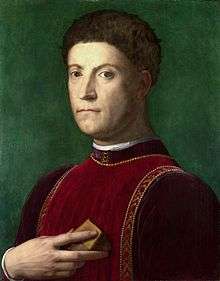Piero di Cosimo de' Medici
| Piero the Gouty | |
|---|---|
 Portrait of Piero by Bronzino. | |
| Lord of Florence | |
| Reign | 1 August 1464 – 2 December 1469 |
| Predecessor | Cosimo the Elder |
| Successor | Lorenzo the Magnificent |
| Spouse(s) | Lucrezia Tornabuoni |
|
Issue | |
| Noble family | House of Medici |
| Father | Cosimo de' Medici |
| Mother | Contessina de' Bardi |
| Born |
19 September 1416 Florence, Republic of Florence |
| Died |
2 December 1469 (aged 53) Florence, Republic of Florence |

Piero di Cosimo de' Medici (the Gouty), (Italian: Piero "il Gottoso") (1416 – 2 December 1469)[1] was the de facto ruler of Florence from 1464 to 1469, during the Italian Renaissance.
Biography
Piero was the son of Cosimo de' Medici the Elder and Contessina de' Bardi.[2] During his father's life he did not play an extensive role due to his perpetual poor health, the source of his nickname. His brother Giovanni was named as Cosimo's executor, but predeceased his father. In 1461, Piero was the last Medici elected to the office of Gonfaloniere. His gout often kept him confined to bed.[3] This meant that his bedroom effectively became his office where he would conduct political meetings, and led to the Medici palace becoming the seat of government.[3]
Upon taking over the family Medici bank from his father, Piero had a financial overview prepared. The results led him to call up a number of long-standing loans, many to various Medici supporters, which his father had let stand. This immediately drove a good number of the merchants involved into bankruptcy, and added to the ranks of those who opposed the Medici. Although not as brilliant a banker as his father, he was able to keep things running smoothly during his tenure.
His time as leader of Florence was marked by an attempted coup led by Luca Pitti, Niccolò Soderini, Diotisalvi Neroni, Angelo Acciaiuoli and his cousin Pierfrancesco de' Medici, using troops provided by Borso d'Este, Duke of Modena and Reggio, and commanded by his brother Ercole d'Este (planned for 26 August 1466). Piero was warned by Giovanni II Bentivoglio, and was able to escape the coup, in part because his son Lorenzo discovered a road-block set up by the conspirators to capture Piero in his trip towards the Medici villa at Careggi; he was not recognized, and was able to warn his father. The coup failed, as did an attempted repeat backed by Venice, using troops commanded by Bartolomeo Colleoni. It has been argued[4] that the "coup" was in fact a legitimate attempt to limit the power of the Medici faction and restore a system of government in keeping with Florence's traditional republican ideals, and that to refer to it as a "coup" or a "conspiracy" legitimizes Piero's de facto and hereditary (but wholly unconstitutional) status as leader of the city.
In 1467 Piero had to face the war against the Republic of Venice, prompted by the Florentine support given to Galeazzo Maria Sforza, the new duke of Milan. However, the Venetian army under Colleoni was defeated at the Battle of Molinella by the league of Florence, Naples, Papal States and Milan.
He also continued the family's tradition of artistic patronage, including Gozzoli's fresco Procession of the Magi in Palazzo Medici Riccardi (in which are also present both of Piero's sons, Lorenzo and Giuliano, as well as Piero himself). His taste was more eclectic than that of his father, extending to Dutch and Flemish work. He also continued to collect rare books, adding many to the Medici collections.
He died in 1469, due to gout and lung disease, and is buried in the Church of San Lorenzo, next to his brother Giovanni. The tomb, created by Andrea del Verrocchio, was commissioned by his sons Lorenzo and Giuliano.
Marriage and Issue
On 3 Jun 1444[5] Piero married Lucrezia Tornabuoni (1427–1482).[2] Their children include Lorenzo the Magnificent and Giuliano de' Medici.[2] All his family is probably portrayed in the famous painting by Botticelli, called "Madonna del Magnificat" (Madonna of the Magnificat), where Lucrezia Tornabuoni appears as the Virgin Mary. Their children are:
- Maria (may have been illegitimate)[6] (died before 1473) - married Leonetto Rossi[2]
- Bianca (c. 1445-1488) - married Guglielmo Pazzi[2]
- Lucrezia "Nannina" (1447-1493)[2]
- Lorenzo the Magnificent (1449-1492)[2]
- Giuliano (1453-1478)[2]
- Giovanni (illegitimate)
References
- ↑ Encyclopædia Britannica Online 2015.
- 1 2 3 4 5 6 7 8 Tomas 2003, p. 7.
- 1 2 Tomas 2003, p. 48.
- ↑ Najemy, John M. (2006). A History of Florence 1200-1575. Blackwell Publishing. ISBN 978-1405119542.
- ↑ Tomas 2003, p. 17.
- ↑ Pernis & Adams 2006, p. 29.
| Wikimedia Commons has media related to Piero de' Medici. |
Sources
- Pernis, Maria Grazia; Adams, Laurie (2006). Lucrezia Tornabuoni De' Medici and the Medici Family in the Fifteenth Century. New York: Peter Lang Publishing, Inc. ISBN 978-0820476452.
- Tomas, Natalie R. (2003). The Medici Women: Gender and Power in Renaissance Florence. Aldershot: Ashgate. ISBN 0754607771.
- "Piero di Cosimo de' Medici". Encyclopædia Britannica Online. 2015. Retrieved 10 Dec 2015.
- Najemy, John M. (2006). A History of Florence 1200-1575. Chichester: Blackwell Publishing. ISBN 978-1405119542.